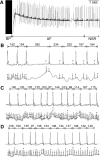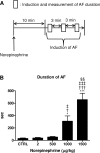Norepinephrine-Induced Adrenergic Activation Strikingly Increased the Atrial Fibrillation Duration through β1- and α1-Adrenergic Receptor-Mediated Signaling in Mice
- PMID: 26203906
- PMCID: PMC4512675
- DOI: 10.1371/journal.pone.0133664
Norepinephrine-Induced Adrenergic Activation Strikingly Increased the Atrial Fibrillation Duration through β1- and α1-Adrenergic Receptor-Mediated Signaling in Mice
Abstract
Background: Atrial fibrillation (AF) is the most common arrhythmias among old people. It causes serious long-term health problems affecting the quality of life. It has been suggested that the autonomic nervous system is involved in the onset and maintenance of AF in human. However, investigation of its pathogenesis and potential treatment has been hampered by the lack of suitable AF models in experimental animals.
Objectives: Our aim was to establish a long-lasting AF model in mice. We also investigated the role of adrenergic receptor (AR) subtypes, which may be involved in the onset and duration of AF.
Methods and results: Trans-esophageal atrial burst pacing in mice could induce AF, as previously shown, but with only a short duration (29.0 ± 8.1 sec). We found that adrenergic activation by intraperitoneal norepinephrine (NE) injection strikingly increased the AF duration. It increased the duration to more than 10 minutes, i.e., by more than 20-fold (656.2 ± 104.8 sec; P<0.001). In this model, a prior injection of a specific β1-AR blocker metoprolol and an α1-AR blocker prazosin both significantly attenuated NE-induced elongation of AF. To further explore the mechanisms underlying these receptors' effects on AF, we assessed the SR Ca(2+) leak, a major trigger of AF, and consequent spontaneous SR Ca(2+) release (SCR) in atrial myocytes. Consistent with the results of our in-vivo experiments, both metoprolol and prazosin significantly inhibited the NE-induced SR Ca(2+) leak and SCR. These findings suggest that both β1-AR and α1-AR may play important roles in the development of AF.
Conclusions: We have established a long-lasting AF model in mice induced by adrenergic activation, which will be valuable in future AF study using experimental animals, such as transgenic mice. We also revealed the important role of β1- and α1-AR-mediated signaling in the development of AF through in-vivo and in-vitro experiments.
Conflict of interest statement
Figures





Similar articles
-
Adrenoceptor sub-type involvement in Ca2+ current stimulation by noradrenaline in human and rabbit atrial myocytes.Pflugers Arch. 2022 Dec;474(12):1311-1321. doi: 10.1007/s00424-022-02746-z. Epub 2022 Sep 22. Pflugers Arch. 2022. PMID: 36131146 Free PMC article.
-
Diverse regulation of cardiac expression of relaxin receptor by α1- and β1-adrenoceptors.Cardiovasc Drugs Ther. 2014 Jun;28(3):221-8. doi: 10.1007/s10557-014-6525-x. Cardiovasc Drugs Ther. 2014. PMID: 24852484
-
Suppression of collagen production in norepinephrine stimulated cardiac fibroblasts culture: differential effect of alpha and beta-adrenoreceptor antagonism.Cardiovasc Drugs Ther. 2009 Aug;23(4):271-80. doi: 10.1007/s10557-009-6183-6. Cardiovasc Drugs Ther. 2009. PMID: 19575289
-
Cardiac adrenergic control and atrial fibrillation.Naunyn Schmiedebergs Arch Pharmacol. 2010 Mar;381(3):235-49. doi: 10.1007/s00210-009-0474-0. Epub 2009 Dec 4. Naunyn Schmiedebergs Arch Pharmacol. 2010. PMID: 19960186 Free PMC article. Review.
-
Autonomic nerve activity and atrial fibrillation.Heart Rhythm. 2007 Mar;4(3 Suppl):S61-4. doi: 10.1016/j.hrthm.2006.12.006. Epub 2006 Dec 15. Heart Rhythm. 2007. PMID: 17336887 Free PMC article. Review.
Cited by
-
microRNAs as Biomarkers of Endothelial Dysfunction and Therapeutic Target in the Pathogenesis of Atrial Fibrillation.Int J Mol Sci. 2023 Mar 10;24(6):5307. doi: 10.3390/ijms24065307. Int J Mol Sci. 2023. PMID: 36982382 Free PMC article. Review.
-
Chemically Homogenous Compounds with Antagonistic Properties at All α1-Adrenoceptor Subtypes but not β1-Adrenoceptor Attenuate Adrenaline-Induced Arrhythmia in Rats.Front Pharmacol. 2016 Aug 3;7:229. doi: 10.3389/fphar.2016.00229. eCollection 2016. Front Pharmacol. 2016. PMID: 27536240 Free PMC article.
-
The Subtype Selectivity in Search of Potent Hypotensive Agents among 5,5-Dimethylhydantoin Derived α1-Adrenoceptors Antagonists.Int J Mol Sci. 2023 Nov 22;24(23):16609. doi: 10.3390/ijms242316609. Int J Mol Sci. 2023. PMID: 38068933 Free PMC article.
-
Effects of occlusal disharmony on susceptibility to atrial fibrillation in mice.Sci Rep. 2020 Aug 13;10(1):13765. doi: 10.1038/s41598-020-70791-8. Sci Rep. 2020. PMID: 32792672 Free PMC article.
-
Ethanolic Extracts of Cupressaceae Species Conifers Provide Rapid Protection against Barium Chloride-Induced Cardiac Arrhythmia.Pharmaceuticals (Basel). 2024 Jul 29;17(8):1003. doi: 10.3390/ph17081003. Pharmaceuticals (Basel). 2024. PMID: 39204108 Free PMC article.
References
-
- Ortiz J, Niwano S, Abe H, Rudy Y, Johnson NJ, Waldo AL (1994) Mapping the conversion of atrial flutter to atrial fibrillation and atrial fibrillation to atrial flutter. Insights into mechanisms. Circ Res 74: 882–894. - PubMed
-
- January CT, Wann LS, Alpert JS, Calkins H, Cigarroa JE, Cleveland JC Jr, et al. (2014) 2014 AHA/ACC/HRS Guideline for the Management of Patients With Atrial Fibrillation: A Report of the American College of Cardiology/American Heart Association Task Force on Practice Guidelines and the Heart Rhythm Society. J Am Coll Cardiol 64: e1–e76. 10.1016/j.jacc.2014.03.022 - DOI - PubMed
-
- Heeringa J, van der Kuip DA, Hofman A, Kors JA, van Herpen G, Stricker BH, et al. (2006) Prevalence, incidence and lifetime risk of atrial fibrillation: the Rotterdam study. Eur Heart J 27: 949–953. - PubMed
-
- Lloyd-Jones DM, Wang TJ, Leip EP, Larson MG, Levy D, Vasan RS, et al. (2004) Lifetime risk for development of atrial fibrillation: the Framingham Heart Study. Circulation 110: 1042–1046. - PubMed
Publication types
MeSH terms
Substances
LinkOut - more resources
Full Text Sources
Other Literature Sources
Medical
Research Materials
Miscellaneous

